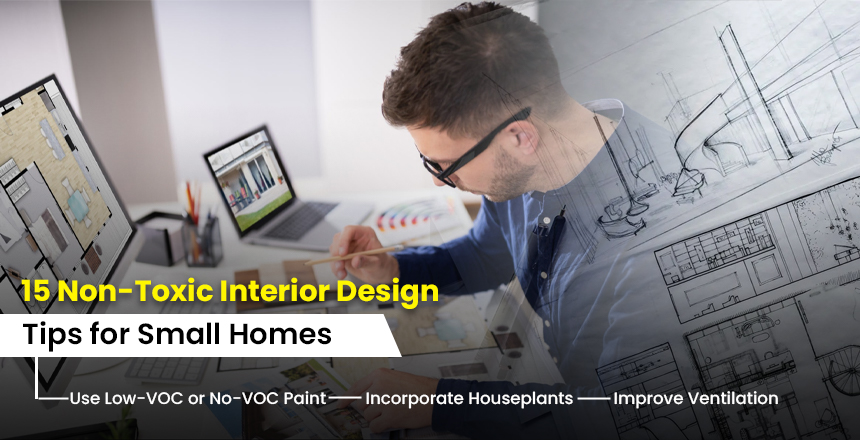Today more and more people strive for environmentally friendly design solutions, especially
when it comes to the interior design of small apartments. For the desired environmentally
friendly practices and behaviors, homeowners and interior designers are searching for ways on
how they could bring these ideas into their houses. The process of bringing into being a small
space with environmentally friendly considerations goes hand in hand with the client’s living
environment while at the same time having the benefit of adding to humanity’s welfare.
Choose Sustainable Materials:
If possible, select materials that have minimal effects on animal life and other living organisms.
And they should select more reliable and easily renewable floor materials, including reclaimed
woods, bamboo, or cork. Keep the synthetic fabrics off your furniture or floor coverings and go
for the more natural stuff like cotton, linen, or wool.
Utilize Space Efficiently:
Space utilization is therefore very useful when designing a small green space. Choose furniture
and storage systems that are compact and that can do more than one job at a time. In case the
space is sparse, furniture like the Murphy bed, wall bookshelf, or storage space that folds and
blends into the wall is recommended.Incorporate Natural Light:
Incorporate Natural Light:
When it comes to small rooms, try and get as much natural light inside as possible through the
window and use sheer curtains or blinds. Also, this reduced artificial lighting can be applied to
save energy, as the vast majority of the lighting is done naturally during the day.
Install Energy-Efficient Lighting:
Begin replacing those traditional incandescent bulbs with energy-efficient products such as LED
or CFL bulbs. Incandescent and these other bulbs use less energy and are also longer-lasting,
thus contributing less to the greenhouse gases used in lighting our homes.
Choose Sustainable Furniture:
Choose furniture that is made from ecofriendly material or furniture that has been recycled. First
of all, select the furniture that is environmentally friendly; for example, it has been made of
recycled materials, or the chair and table are easy to be disassembled to recycle the materials
after their use.
Plant a Vertical Garden:
As you incorporate green plants into your small home, they will help to beautify the environment
as well as improve the air quality of your home. Why not try fixing a landscape wall inside your
house? It saves a lot of space and creates an environment for the plant to grow. This can be
done by having a hanging basket, a wall planter, or a vertical planting rack.
Energy-Efficient Appliances:
Since the homeowner has a small area, he or she should consider incorporating energy-efficient
appliances into the area, such as those certified to use Energy Star appliances. By using such
appliances, their energy consumption is always lower, and environmental impact and costs are
low.
Use Eco-Friendly Paint:
Paints that have low or no volatile organic compounds will help decrease the amount of indoor
air pollution as well as improve the indoor air quality. These paints allow the release of fewer of
these volatile organic compounds, which are harmful to people and the physical environment.
Implement Smart Technology:
There is a smart system that helps to regulate heating/cooling in your house and the use of lights in a small place. Smart thermostats can set the temperatures in your home to automatically change when you’re gone, and smart lighting systems can also turn off remotely to ensure there are no accidentally left-on lights in your residence.
Reusable and Biodegradable Products:
Use reusable products or those that are naturally degradable instead of paper towels or plastic
takeout bags, for instance. To prevent the use of disposables and to be eco-friendly, buy cloth
napkins, beeswax wraps, and glass containers.
Recycle and Repurpose:
If at all possible, try to avoid wastage and use all materials over again! Eco-friendly also means
looking for ways to use items in other ways, for instance, using a ladder as a bookshelf or glass
jars for storage. This helps to avoid cluttering and at the same time make your small home more
personal.
Use Natural Materials:
Add some natural elements like stone, wood, or fabric into the interior elements, and you will
feel warm and comfortable. Such materials sometimes may be less damaging to the
environment than those that are artificially produced.
Limit Clutter:
Nowhere is it worse than in a small home because it gives an illusion of having less space than what is actually available, so cut down on clutter. Purchase shelving and other storage products that will meet your needs and avoid getting complicated and fancy shelf units.
Use Energy-Efficient Windows:
For better insulation, replace standard windows with double- or low-E windows to achieve
improved heat-resistant features to heat your small house.
Encourage Natural Insulation:
Small space insulation can be done using natural insulating materials like sheep wool or
cellulose to make space more energy efficient. These materials are recyclable and offer better
thermal performance than synthetic materials commonly used in construction today.
Conclusion:
Interior design can be a challenge in general, and eco-friendly interior design for a small space
can be a rather rewarding yet complicated task. Use the following fifteen green interior design
tips to learn how you can make a living space as environmentally friendly as it is beautiful.
Consciously choose natural materials, make the best of small spaces, and opt for
energy-efficient technologies that will help create a beautiful small space that is friendly to the
environment as well.








